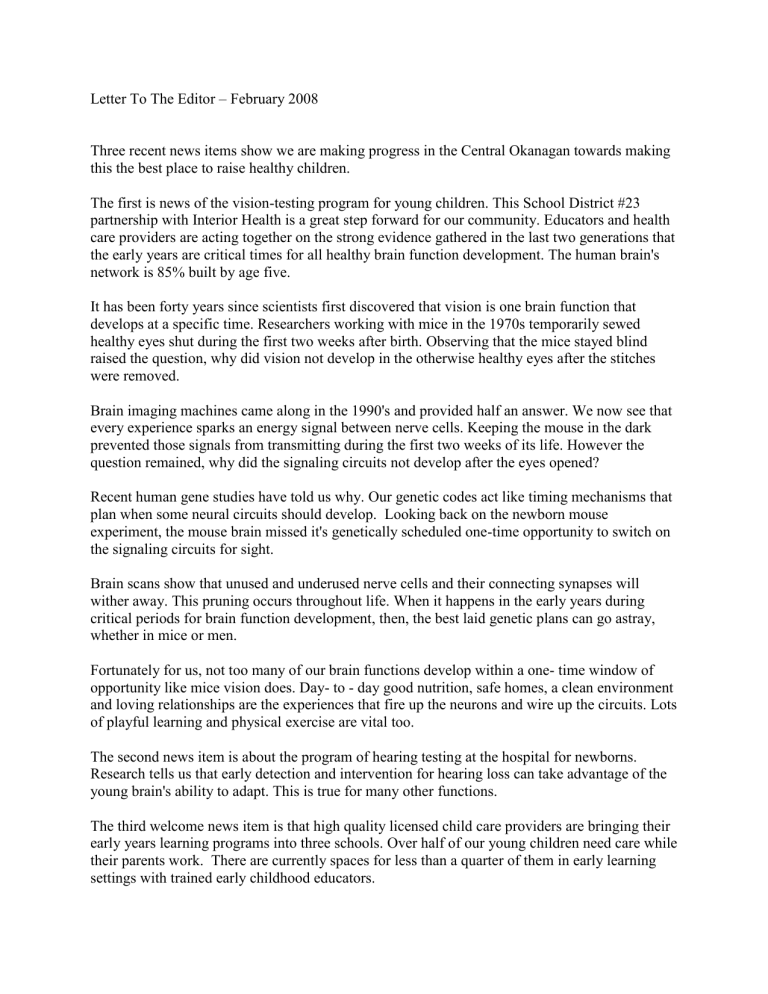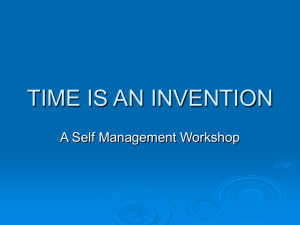February 2008 Three Steps Towards Children`s Health

Letter To The Editor – February 2008
Three recent news items show we are making progress in the Central Okanagan towards making this the best place to raise healthy children.
The first is news of the vision-testing program for young children. This School District #23 partnership with Interior Health is a great step forward for our community. Educators and health care providers are acting together on the strong evidence gathered in the last two generations that the early years are critical times for all healthy brain function development. The human brain's network is 85% built by age five.
It has been forty years since scientists first discovered that vision is one brain function that develops at a specific time. Researchers working with mice in the 1970s temporarily sewed healthy eyes shut during the first two weeks after birth. Observing that the mice stayed blind raised the question, why did vision not develop in the otherwise healthy eyes after the stitches were removed.
Brain imaging machines came along in the 1990's and provided half an answer. We now see that every experience sparks an energy signal between nerve cells. Keeping the mouse in the dark prevented those signals from transmitting during the first two weeks of its life. However the question remained, why did the signaling circuits not develop after the eyes opened?
Recent human gene studies have told us why. Our genetic codes act like timing mechanisms that plan when some neural circuits should develop. Looking back on the newborn mouse experiment, the mouse brain missed it's genetically scheduled one-time opportunity to switch on the signaling circuits for sight.
Brain scans show that unused and underused nerve cells and their connecting synapses will wither away. This pruning occurs throughout life. When it happens in the early years during critical periods for brain function development, then, the best laid genetic plans can go astray, whether in mice or men.
Fortunately for us, not too many of our brain functions develop within a one- time window of opportunity like mice vision does. Day- to - day good nutrition, safe homes, a clean environment and loving relationships are the experiences that fire up the neurons and wire up the circuits. Lots of playful learning and physical exercise are vital too.
The second news item is about the program of hearing testing at the hospital for newborns.
Research tells us that early detection and intervention for hearing loss can take advantage of the young brain's ability to adapt. This is true for many other functions.
The third welcome news item is that high quality licensed child care providers are bringing their early years learning programs into three schools. Over half of our young children need care while their parents work. There are currently spaces for less than a quarter of them in early learning settings with trained early childhood educators.
Public policy can further encourage community partnerships and programs to tackle other preventable harms. Inadequate child care, malnutrition, exposures to toxins, and overwhelming stress harm young developing brains, sometimes permanently. These cause long-term ill effects.
The costs for corrective health, education, social welfare or justice system measures are very high. Consider this. One quarter of our children in the Central Okanagan enter kindergarten showing measurable signs that conditions during their early years have put their future well being at risk.
The Community Action Toward Children's Heath coalition is a growing community based partnership that invites everyone to envision how we can continue this excellent public and private investment trend. Please visit our website to learn more about brain development and the community's priorities in the Central Okanagan Early Childhood Development plan at http://www.catchcoalition.ca.
Dwayne Emerson
Manager, Community Action Toward Children’s Health
Community Action Toward Children’s Health
1511 Sutherland Avenue, Kelowna BC V1Y 5Y7
Telephone: 868-2413











